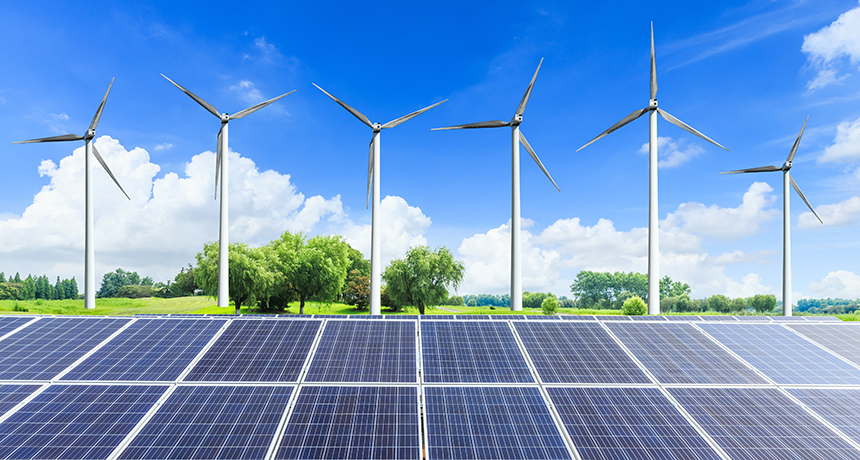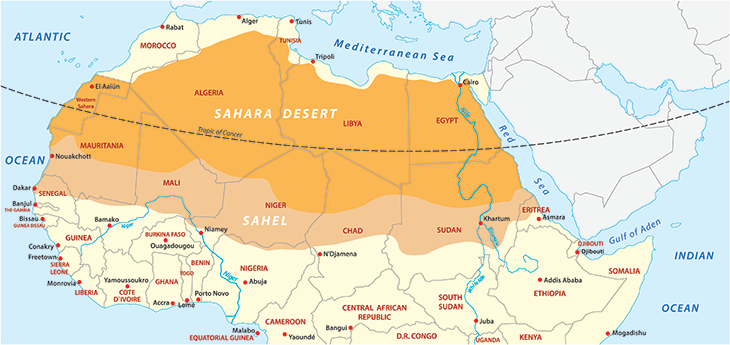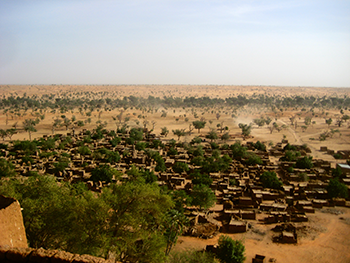Renewable energy might be able to green a desert
Wind turbines and solar panels appear able to boost nearby rains — and plant growth

Large wind and solar farms could change the amount of rain in nearby areas.
Wind turbines and solar panels that create electricity are examples of environmentally friendly — or “green” — technology. A new study finds that these forms of renewable energy might be green in another sense, too. Large collections of those turbines or so-called farms of solar panels appear capable of bringing rains to the desert. And that would allow more plants to grow.
Eugenia Kalnay is an expert on weather and climate. She works at the University of Maryland in College Park. She also has worked for the National Weather Service and NASA. In each place, she has used computers to model weather and climate. Such models help scientists understand how temperatures and rain might change over time. Day-to-day changes are known as weather. Longer-term patterns, such as seasonal trends that persist for years, describe a region’s climate.
Wind turbines and solar panels can change how air moves. As winds move through the spinning blades of a turbine, some of their power is converted to electricity. This weakens those winds. Turbines may also change the path of the winds, directing some share of them around the outside of the wind farm.
Both technologies also can affect nearby temperatures. Solar panels can raise the adjacent temperature by 3 to 4 degrees Celsius (5 to 7 degrees Fahrenheit). Turbines also boost temperatures, largely by keeping the nights warmer. Warm air rises. If it rises high enough, and holds much water vapor, it could eventually condense into clouds that produce rain.
In these ways, wind and solar farms could affect climate. But would the changes be large enough to matter? That’s what Kalnay and others wanted to know. Their new computer models show that a mix of these energy technologies might boost rainfall and eventually transform deserts into plant-rich areas.
Putting it to the test
Kalnay teamed up with Safa Motesharrei, a systems scientist at Maryland. Systems scientists study how complex systems, such as climate, function. The Maryland pair recruited Yan Li, a geoscientist at Beijing Normal University in China, to join them. These three brought in other scientists from Maryland, Italy and China to join in their study. Building large wind or solar farms just to study their question was not an option. It would be too costly. It might also create unexpected climate issues. So the team instead used computer models to probe how wind turbines and solar farms might alter a region’s climate.
Weather and climate models work from data collected over decades. They include data on the weather that developed when certain conditions were in place. These conditions included temperature and rains or snowfall. They also included the air pressure, winds, sunlight and the movement of heat into and out of the ground and large bodies of water.
For their new study, the researchers developed a model of North Africa’s Sahara Desert. The world’s largest desert, the Sahara supports little life. Although few people live here, many reside in the areas around it. So putting wind and solar farms in this area could help meet their electricity needs.

The southern edge of the desert is an area called the Sahel. In this transition zone, the desert becomes a grassy savanna dotted with trees. There isn’t much rainfall in the Sahel, and climate change has reduced those rains in recent years. Because growing crops helps to feed the local people, rains are important here.
The team ran its model several times. In one run, it assumed that people would erect wind farms only. Another run assumed people would install just solar farms. A third assumed people would build both. All three of these scenarios would affect the desert’s weather — but differently, the model showed.
Wind farms raised the temperature by an average of 2.16 degrees Celsius (3.89 degrees Fahrenheit). Most of that increase occurred at night, when the land cooled down less than normal. Wind turbines also doubled the Sahara’s rainfall, which doubled in the Sahara. But doubling a small number still ends up being a small effect. The average daily rain increased by only 0.25 millimeter (0.01 inch). The Sahel would see a slightly bigger daily increase, the model projected — 1.12 millimeters (0.04 inch) more rain.
Solar farms would increase temperatures less, by 1.12 degrees Celsius (2.02 degrees Fahrenheit), the models showed. And that change occurred mainly during the day. They’d also increase average rain per day, but less than the wind farms would. The increase could add up to an extra 47.5 millimeters (1.9 inches) per year in the desert and by 208 millimeters (8.2 inches) in the Sahel.

Installing a mix of solar farms and wind turbines brought about a bigger change — not in temperature but in rainfall. In the Sahara, having both wind and solar farms more than doubled the amount of rain that fell, up to 215.4 millimeters (8.5 inches) per day. The nearby Sahel would see an even more dramatic boost — up to 500 millimeters (20 inches) of additional rain each year.
The models predicted that the average rainfall would increase over time, as more plants grew. Plants move water from the ground to the air. The process they use has a long name: evapotranspiration (Ee-VAP-oh-tran-spur-AY-shun). Warmer air can carry more water. So as this air rises, it can ferry more water up to become clouds. Those clouds can release rain, slaking the thirst of plants below. Over time, this process repeats itself over and over. This so-called positive feedback can greatly boost rains. That’s especially true in the Sahel, the models showed, where people rely on that water.
Eventually, the models showed, rainfall would level off at some new, higher amount. That’s because plants would now be a consistent part of the landscape and the climate more stable.
Kalnay and her colleagues described this trend September 7 in Science.
Such rainfall changes could lead to better agriculture, says Motesharrei. More rain also would help wild plants grow, he adds, giving livestock more to graze on.
“We believe that the countries in the Sahara and nearby Sahel region should seriously consider investing in wind and solar power,” say Motesharrei and Li. This would produce large amounts of clean, renewable electricity, they argue. As an added benefit, it would bring rain to a region that has been getting drier.
Not a simple solution
“The impact of solar [farms] on climate and ecosystems is complex,” notes Ibrahima Diédhiou. He’s an ecologist in West Africa at the Université de Thiès in Senegal. Solar farms could have boost rains in the Sahel, he says. But they also might cut how much carbon dioxide (a greenhouse gas) is taken up by crops, pastures and forests. So the overall impact on climate change could be mixed, he says.
Unintended effects might go beyond climate issues, warns Rebecca Hernandez. She is an ecologist at the University of California, Davis who specializes in dry landscapes, such as deserts. Wind turbines and solar farms often disturb ecosystems in ways that lets invasive plant species take over, she says. As the edge out native plants, animals that depend on those native plants could also suffer.
People clearly need to think carefully about how and where they site renewable energy farms, Hernandez says. Putting wind and solar farms in places where people have already built cities and towns would be particularly helpful, she argues. Their environment has already been disrupted, she notes, so adding the energy systems might not cause all that much additional harm. What’s more, these are where people use the most energy.







